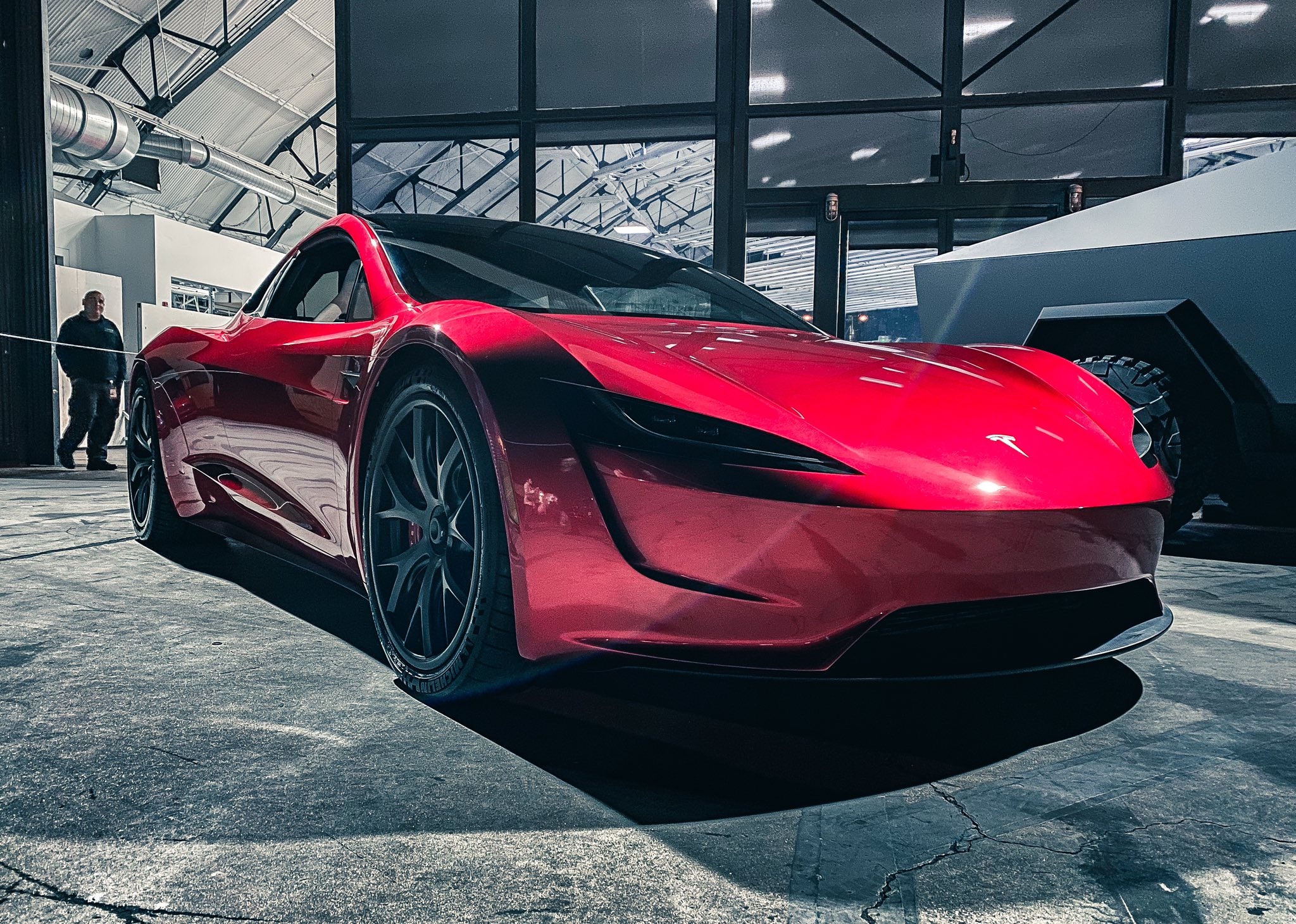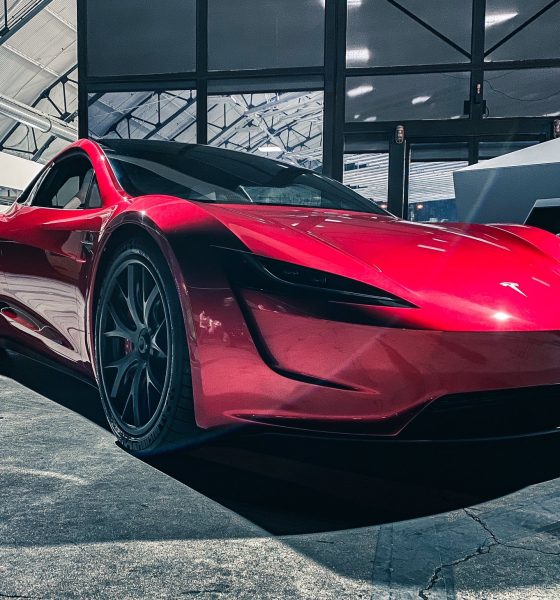

News
Tesla’s Elon Musk reveals rare details on next-gen Roadster’s SpaceX thrusters
Tesla is no stranger to wild designs and insane specs that become even crazier in production. The Cybertruck is the perfect representation of this, as the vehicle is designed quite unlike any other pickup in the market. But that’s just Tesla. The company is never one to shy away from a crazy idea, and among today’s carmakers, it is one of the few that actually follows through.
The next-generation Roadster is poised to become Tesla’s halo car, a vehicle that is the physical representation of why electric propulsion is indisputably superior to the internal combustion engine. During its unveiling, the new Roadster shocked the auto industry with its insane specs, which are headlined by its 0-60 mph time of 1.9 seconds, its top speed of over 250 mph, and its range of 620 miles per charge. But then CEO Elon Musk stated something even crazier: these are the specs of the Roadster’s base model.
This meant that there are even more extreme versions of the next-generation Roadster. Among these is something that Musk has dubbed as the “SpaceX Package,” on account of the vehicle using the private space firm’s Composite Overwrapped Pressure Vessel (COPV), which are also used in the Falcon 9. The idea of using such components in a road-going vehicle is nothing short of insane, but as noted by Elon Musk in a recent preview of the Cybertruck’s appearance at Jay Leno’s Garage, he actually is very serious.
Standing by the flagship supercar and the newly-released Model Y crossover, Musk and Leno were recently featured in a promo video talking about the next-generation Roadster. Leno, for one, noted that sometimes, Musk’s ideas are so out of this world that he can’t really tell if the CEO is joking or not. Musk responded that when it comes to the Roadster’s rocket thrusters, he actually is serious. He then described exactly how the “main” thruster of the next-generation Roadster works.
“We’re gonna use ultra high pressure compressed air. It’s a cold gas thruster. The main thruster will be behind the license plate. So for acceleration, it drops the license plate, and behind the license plate is a rocket thruster. It’s like full-on James Bond,” Musk said.
With its SpaceX Package, the next-generation Roadster will likely be a very difficult vehicle to match in a straight line and on the track. Musk has already stated that the all-electric supercar will set new records in the Nurburgring, and that the Roadster’s acceleration will feel like the Space Shuttle, pulling 3 Gs when it launches.
That being said, Musk has also stated that the Roadster will only be produced in limited quantities. He expects the vehicle to see a production of about 10,000 units per year. That’s just a fraction of the volume of the company’s other vehicles, including the flagship Model S and Model X. Yet, in the world of supercars and machines that almost bend physics with their sheer insanity, 10,000 units per year may be enough to disrupt the entire supercar industry.
Elon Musk and Jay Leno talk about the 2020 Tesla Roadster from CNBC.

Elon Musk
Elon Musk and Tesla AI Director share insights after empty driver seat Robotaxi rides
The executives’ unoccupied tests hint at the rapid progress of Tesla’s unsupervised Robotaxi efforts.

Tesla CEO Elon Musk and AI Director Ashok Elluswamy celebrated Christmas Eve by sharing personal experiences with Robotaxi vehicles that had no safety monitor or occupant in the driver’s seat. Musk described the system’s “perfect driving” around Austin, while Elluswamy posted video from the back seat, calling it “an amazing experience.”
The executives’ unoccupied tests hint at the rapid progress of Tesla’s unsupervised Robotaxi efforts.
Elon and Ashok’s firsthand Robotaxi insights
Prior to Musk and the Tesla AI Director’s posts, sightings of unmanned Teslas navigating public roads were widely shared on social media. One such vehicle was spotted in Austin, Texas, which Elon Musk acknowleged by stating that “Testing is underway with no occupants in the car.”
Based on his Christmas Eve post, Musk seemed to have tested an unmanned Tesla himself. “A Tesla with no safety monitor in the car and me sitting in the passenger seat took me all around Austin on Sunday with perfect driving,” Musk wrote in his post.
Elluswamy responded with a 2-minute video showing himself in the rear of an unmanned Tesla. The video featured the vehicle’s empty front seats, as well as its smooth handling through real-world traffic. He captioned his video with the words, “It’s an amazing experience!”
Towards Unsupervised operations
During an xAI Hackathon earlier this month, Elon Musk mentioned that Tesla owed be removing Safety Monitors from its Robotaxis in Austin in just three weeks. “Unsupervised is pretty much solved at this point. So there will be Tesla Robotaxis operating in Austin with no one in them. Not even anyone in the passenger seat in about three weeks,” he said. Musk echoed similar estimates at the 2025 Annual Shareholder Meeting and the Q3 2025 earnings call.
Considering the insights that were posted Musk and Elluswamy, it does appear that Tesla is working hard towards operating its Robotaxis with no safety monitors. This is quite impressive considering that the service was launched just earlier this year.
Elon Musk
Starlink passes 9 million active customers just weeks after hitting 8 million
The milestone highlights the accelerating growth of Starlink, which has now been adding over 20,000 new users per day.

SpaceX’s Starlink satellite internet service has continued its rapid global expansion, surpassing 9 million active customers just weeks after crossing the 8 million mark.
The milestone highlights the accelerating growth of Starlink, which has now been adding over 20,000 new users per day.
9 million customers
In a post on X, SpaceX stated that Starlink now serves over 9 million active users across 155 countries, territories, and markets. The company reached 8 million customers in early November, meaning it added roughly 1 million subscribers in under seven weeks, or about 21,275 new users on average per day.
“Starlink is connecting more than 9M active customers with high-speed internet across 155 countries, territories, and many other markets,” Starlink wrote in a post on its official X account. SpaceX President Gwynne Shotwell also celebrated the milestone on X. “A huge thank you to all of our customers and congrats to the Starlink team for such an incredible product,” she wrote.
That growth rate reflects both rising demand for broadband in underserved regions and Starlink’s expanding satellite constellation, which now includes more than 9,000 low-Earth-orbit satellites designed to deliver high-speed, low-latency internet worldwide.
Starlink’s momentum
Starlink’s momentum has been building up. SpaceX reported 4.6 million Starlink customers in December 2024, followed by 7 million by August 2025, and 8 million customers in November. Independent data also suggests Starlink usage is rising sharply, with Cloudflare reporting that global web traffic from Starlink users more than doubled in 2025, as noted in an Insider report.
Starlink’s momentum is increasingly tied to SpaceX’s broader financial outlook. Elon Musk has said the satellite network is “by far” the company’s largest revenue driver, and reports suggest SpaceX may be positioning itself for an initial public offering as soon as next year, with valuations estimated as high as $1.5 trillion. Musk has also suggested in the past that Starlink could have its own IPO in the future.
News
NVIDIA Director of Robotics: Tesla FSD v14 is the first AI to pass the “Physical Turing Test”
After testing FSD v14, Fan stated that his experience with FSD felt magical at first, but it soon started to feel like a routine.

NVIDIA Director of Robotics Jim Fan has praised Tesla’s Full Self-Driving (Supervised) v14 as the first AI to pass what he described as a “Physical Turing Test.”
After testing FSD v14, Fan stated that his experience with FSD felt magical at first, but it soon started to feel like a routine. And just like smartphones today, removing it now would “actively hurt.”
Jim Fan’s hands-on FSD v14 impressions
Fan, a leading researcher in embodied AI who is currently solving Physical AI at NVIDIA and spearheading the company’s Project GR00T initiative, noted that he actually was late to the Tesla game. He was, however, one of the first to try out FSD v14.
“I was very late to own a Tesla but among the earliest to try out FSD v14. It’s perhaps the first time I experience an AI that passes the Physical Turing Test: after a long day at work, you press a button, lay back, and couldn’t tell if a neural net or a human drove you home,” Fan wrote in a post on X.
Fan added: “Despite knowing exactly how robot learning works, I still find it magical watching the steering wheel turn by itself. First it feels surreal, next it becomes routine. Then, like the smartphone, taking it away actively hurts. This is how humanity gets rewired and glued to god-like technologies.”
The Physical Turing Test
The original Turing Test was conceived by Alan Turing in 1950, and it was aimed at determining if a machine could exhibit behavior that is equivalent to or indistinguishable from a human. By focusing on text-based conversations, the original Turing Test set a high bar for natural language processing and machine learning.
This test has been passed by today’s large language models. However, the capability to converse in a humanlike manner is a completely different challenge from performing real-world problem-solving or physical interactions. Thus, Fan introduced the Physical Turing Test, which challenges AI systems to demonstrate intelligence through physical actions.
Based on Fan’s comments, Tesla has demonstrated these intelligent physical actions with FSD v14. Elon Musk agreed with the NVIDIA executive, stating in a post on X that with FSD v14, “you can sense the sentience maturing.” Musk also praised Tesla AI, calling it the best “real-world AI” today.








